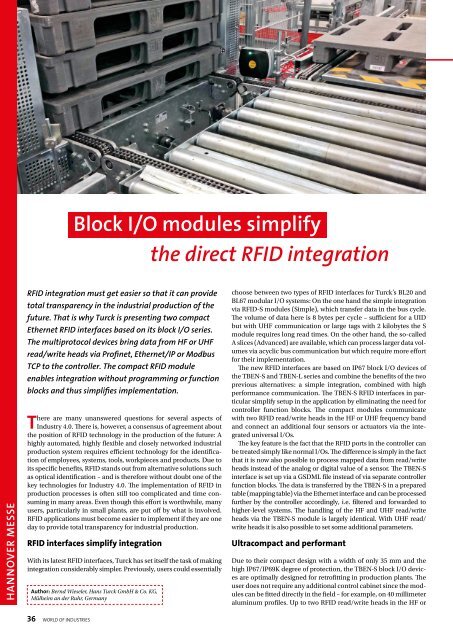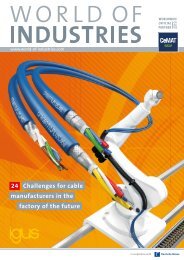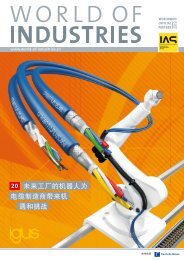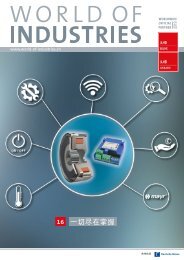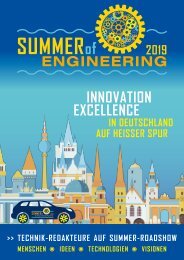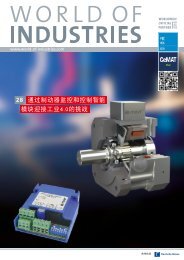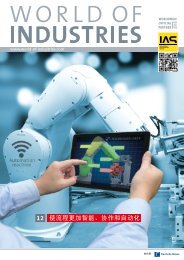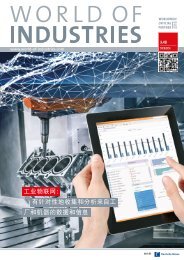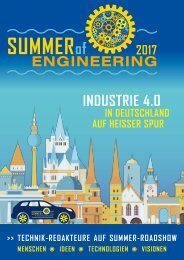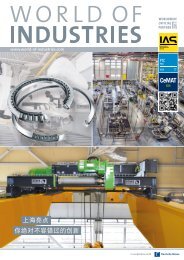world of industries 3/2017 (EN)
world of industries 3/2017 (EN)
world of industries 3/2017 (EN)
- TAGS
- world
- industries
Create successful ePaper yourself
Turn your PDF publications into a flip-book with our unique Google optimized e-Paper software.
Block I/O modules simplify<br />
the direct RFID integration<br />
HANNOVER MESSE<br />
RFID integration must get easier so that it can provide<br />
total transparency in the industrial production <strong>of</strong> the<br />
future. That is why Turck is presenting two compact<br />
Ethernet RFID interfaces based on its block I/O series.<br />
The multiprotocol devices bring data from HF or UHF<br />
read/write heads via Pr<strong>of</strong>inet, Ethernet/IP or Modbus<br />
TCP to the controller. The compact RFID module<br />
enables integration without programming or function<br />
blocks and thus simplifies implementation.<br />
There are many unanswered questions for several aspects <strong>of</strong><br />
Industry 4.0. There is, however, a consensus <strong>of</strong> agreement about<br />
the position <strong>of</strong> RFID technology in the production <strong>of</strong> the future: A<br />
highly automated, highly flexible and closely networked industrial<br />
production system requires efficient technology for the identification<br />
<strong>of</strong> employees, systems, tools, workpieces and products. Due to<br />
its specific benefits, RFID stands out from alternative solutions such<br />
as optical identification – and is therefore without doubt one <strong>of</strong> the<br />
key technologies for Industry 4.0. The implementation <strong>of</strong> RFID in<br />
production processes is <strong>of</strong>ten still too complicated and time consuming<br />
in many areas. Even though this effort is worthwhile, many<br />
users, particularly in small plants, are put <strong>of</strong>f by what is involved.<br />
RFID applications must become easier to implement if they are one<br />
day to provide total transparency for industrial production.<br />
RFID interfaces simplify integration<br />
With its latest RFID interfaces, Turck has set itself the task <strong>of</strong> making<br />
integration considerably simpler. Previously, users could essentially<br />
Author: Bernd Wieseler, Hans Turck GmbH & Co. KG,<br />
Mülheim an der Ruhr, Germany<br />
choose between two types <strong>of</strong> RFID interfaces for Turck’s BL20 and<br />
BL67 modular I/O systems: On the one hand the simple integration<br />
via RFID-S modules (Simple), which transfer data in the bus cycle.<br />
The volume <strong>of</strong> data here is 8 bytes per cycle – sufficient for a UID<br />
but with UHF communication or large tags with 2 kilobytes the S<br />
module requires long read times. On the other hand, the so-called<br />
A slices (Advanced) are available, which can process larger data volumes<br />
via acyclic bus communication but which require more effort<br />
for their implementation.<br />
The new RFID interfaces are based on IP67 block I/O devices <strong>of</strong><br />
the TB<strong>EN</strong>-S and TB<strong>EN</strong>-L series and combine the benefits <strong>of</strong> the two<br />
previous alternatives: a simple integration, combined with high<br />
performance communication. The TB<strong>EN</strong>-S RFID interfaces in particular<br />
simplify setup in the application by eliminating the need for<br />
controller function blocks. The compact modules communicate<br />
with two RFID read/write heads in the HF or UHF frequency band<br />
and connect an additional four sensors or actuators via the integrated<br />
universal I/Os.<br />
The key feature is the fact that the RFID ports in the controller can<br />
be treated simply like normal I/Os. The difference is simply in the fact<br />
that it is now also possible to process mapped data from read/write<br />
heads instead <strong>of</strong> the analog or digital value <strong>of</strong> a sensor. The TB<strong>EN</strong>-S<br />
interface is set up via a GSDML file instead <strong>of</strong> via separate controller<br />
function blocks. The data is transferred by the TB<strong>EN</strong>-S in a prepared<br />
table (mapping table) via the Ethernet interface and can be processed<br />
further by the controller accordingly, i.e. filtered and forwarded to<br />
higher-level systems. The handling <strong>of</strong> the HF and UHF read/write<br />
heads via the TB<strong>EN</strong>-S module is largely identical. With UHF read/<br />
write heads it is also possible to set some additional parameters.<br />
Ultracompact and performant<br />
Due to their compact design with a width <strong>of</strong> only 35 mm and the<br />
high IP67/IP69K degree <strong>of</strong> protection, the TB<strong>EN</strong>-S block I/O devices<br />
are optimally designed for retr<strong>of</strong>itting in production plants. The<br />
user does not require any additional control cabinet since the modules<br />
can be fitted directly in the field – for example, on 40 millimeter<br />
aluminum pr<strong>of</strong>iles. Up to two RFID read/write heads in the HF or<br />
36 WORLD OF INDUSTRIES


